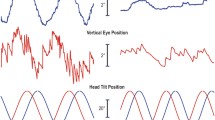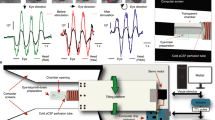Summary
A quantitative study of horizontal and vertical optokinetic nystagmus (OKN) and optocollic reflex (OCR) has been performed in the pigeon using the search-coil technique. The reflexes were analysed in response to either velocity steps or sinusoidal stimulation. Results show that: 1. In response to a velocity step stimulation, the slow phase velocity of both OKN and OCR increases gradually to reach a steady state level. When the stimulation stops in the dark, After Responses (OKAN-I, OKAR-I) occur. Time constants of the OKN charge (or OCR charge) and of the After Responses are lower for vertical than for horizontal responses. 2. In the free-head condition, both the head and the eye display a synchronized nystagmus which add their effects. However, the head reflex (OCR) accounts for about 80–90% of the entire linear gaze response (head + eye), except for the vertical steady state responses which are wholly accomplished by the head (OCR). 3. Both closed-loop and open-loop gains of steady state responses are higher for horizontal than for vertical reflexes. Vertical OCR, horizontal OKN and vertical OKN show properties of binocular integration, the response gain being higher for binocular than for monocular stimulations. By contrast, the horizontal OCR shows little binocular integration but displays a higher response gain for monocular stimulation, compared to horizontal OKN. 4. The horizontal OKN elicited by both monocular and binocular stimulation is asymmetrical, the gain being higher when the eye is driven by a temporo-nasal stimulation. In contrast, both vertical OKN and vertical OCR are practically symmetrical. 5. While both the gain of horizontal OKN and its linear range (up to 20°/s) are improved when the head is free (gaze gain close to 1 up to 40°/s), the vertical OKN and the vertical OCR have similar gain profiles and similar domains of linearity (up to 10°/s). 6. In response to increasing the frequency of a sinusoidal stimulation at constant peak velocity, all the reflexes display a drop in gain and a strong increase of phase lag. The phase increase is greater for horizontal than for vertical reflexes. On the other hand, both gain and phase are higher for OCR than for OKN, both in the horizontal plane as well as in the vertical plane. 7. For sinusoidal stimulations, when the peak velocity (PV) is increased at a constant frequency (0.03 Hz), nonlinearities appear (drop in gain, phase increase) both for OKN and OCR. While the most important parameter which determines the phase is the stimulation frequency, both peak velocity and peak acceleration are involved in the gain saturation.
Similar content being viewed by others
References
Barmack NH, Pettorossi VE, Erickson RG (1980) The influence of bilateral labyrinthectomy on horizontal and vertical optokinetic reflexes in the rabbit. Brain Res 196: 520–524
Boyle R, Büttner V, Markert G (1985) Vestibular nuclei activity and eye movements in the alert monkey during sinusoidal optokinetic stimulation. Exp Brain Res 57: 362–369
Brandt T, Dichgans J, Buchele W (1974) Motion habituation: inverted self-motion perception and optokinetic after-nystagmus. Exp Brain Res 21: 337–352
Britto LRG, Natal CL, Marcondes AM (1981) The accessory optic system in pigeon: receptive field properties of identified neurons. Brain Res 206: 149–154
Bures J, Neverov VP (1979) Reversed postoptokinetic nystagmus: a model of plasticity in the vestibuloocular system. Acta Neurobiol Exp 39: 477–490
Büttner V, Meienberg O, Schimmelpfennig B (1983) The effect of central retinal lesions on optokinetic nystagmus in the monkey. Exp Brain Res 52: 248–256
Büttner V, Waespe W, Henn V (1976) Duration and direction of optokinetic after-nystagmus as a function of stimulus exposure time in the monkey. Arch Psychiat Nervenkr 222: 281–291
Cohen B, Matsuo V, Raphan T (1977) Quantitative analysis of the velocity characteristics of optokinetic nystagmus and optokinetic after-nystagmus. J Physiol 270: 321–344
Collewijn H (1969) Optokinetic eye movements in the rabbit input-output relations. Vision Res 9: 117–132
Collewijn H (1977) Eye- and head movements in freely moving rabbits. J Physiol 266: 471–498
Collewijn H, Noorduin H (1972) Vertical and torsional optokinetic eye movements in the rabbit. Pflügers Arch 332: 87–95
Collewijn H, Winterson BJ, Van der Steen J (1980) Post rotatory nystagmus and optokinetic after-nystagmus in the rabbit linear rather than exponential decay. Exp Brain Res 40: 330–338
Dieringer N, Cochran SL, Precht W (1983) Differences in the central organization of gaze stabilizing reflexes between frog and turtle. J Comp Physiol 153: 495–508
Erickson RG, Barmack NH (1980) A comparison of the horizontal and vertical optokinetic reflexes of the rabbit. Exp Brain Res 40: 448–456
Fite KV (1968) Two types of optomotor response in the domestic pigeon. J Comp Physiol Psychol 66: 308–314
Fukuda T (1959) The unidirectionality of the labyrinthine reflex in relation to the unidirectionality of the optokinetic reflex. Acta Oto-Laryng 50: 507–516
Fuller JH (1981) Eye and head movements during vestibular stimulation in the alert rabbit. Brain Res 205: 363–381
Fuller JH (1985) Eye and head movements in the pigmented rat. Vision Res 25: 1121–1128
Fuller JH (1987) Head movements during optokinetic stimulation in the alert rabbit. Exp Brain Res 65: 593–604
Galifret Y (1968) Les diverses aires fonctionnelles de la rétine du pigeon. Z Zellforsch 86: 535–545
Gioanni H (1988) Stabilizing gaze reflexes in the pigeon (Columba livia). II. Vestibulo-ocular (VOR) and vestibulo-collic (closed-loop VCR) reflexes. Exp Brain Res 69: 583–593
Gioanni H, Rey J, Villalobos J, Bouyer JJ, Gioanni Y (1981) Optokinetic nystagmus in the pigeon (Columba livia). I Study in monocular and binocular vision. Exp Brain Res 44: 362–370
Gioanni H, Rey J, Villalobos J, Dalbera A (1984) Single unit activity in the nucleus of the basal optic root (nBOR) during optokinetic, vestibular and visuo-vestibular stimulations in the alert pigeon (Columba livia). Exp Brain Res 57: 49–60
Gioanni H, Rey J, Villalobos J, Richard D, Dalbera A (1983a) Optokinetic nystagmus in the pigeon (Columba livia). II. Role of the pretectal nucleus of the accessory optic system (AOS). Exp Brain Res 50: 237–247
Gioanni H, Villalobos J, Rey J, Dalbera A (1983b) Optokinetic nystagmus in the pigeon (Columba livia). III. Role of the nucleus ectomamilaris (nEM): interactions in the accessory optic system (AOS). Exp Brain Res 50: 248–258
Godaux E, Gobert C, Halleux J (1983) Vestibuloocular reflex, optokinetic response and their interactions in the alert cat. Exp Neurol 80: 42–54
Gresty MA (1975) Eye, head and body movements of the guinea pig in response to optokinetic stimulation and sinusoidal oscillation in yaw. Pflügers Arch 353: 201–214
Haddad GM, Demer JL, Robinson DA (1980) The effects of lesion of the dorsal cap of the inferior olive on the vestibuloocular and optokinetic systems of the cat. Brain Res 185: 265–275
Hertzler DR, Hayes WN (1969) Effects of monocular vision and midbrain transection on movement detection in the turtle. J Comp Physiol Psychol 67: 473–478
Hess BJM, Precht W, Reber A, Cazin L (1985) Horizontal optokinetic ocular nystagmus in the pigmented rat. Neuroscience 15: 97–107
Hine T (1985) The binocular contribution to monocular optokinetic nystagmus and after nystagmus asymmetries in humans. Vision Res 25: 589–593
Komatsusaki A, Harris HE, Alpert J, Cohen B (1969) Horizontal nystagmus of rhesus monkeys. Acta Oto-Laryng 67: 535–551
Kopp J, Manteuffel G (1984) Quantitative analysis of salamander horizontal head nystagmus. Brain Behav Evol 25: 187–196
Magnin M, Salinger W, Kennedy H (1986) Optokinetic response and visual suppression of the vestibulo-ocular reflex in the open loop condition in the cat. Vision Res 26: 653–660
Maioli C, Precht W (1984) The horizontal optokinetic nystagmus in the cat. Exp Brain Res 55: 494–506
Markner C, Hoffmann KP (1985) Variability in the effects of monocular deprivation on the optokinetic reflex of the nondeprived eye in the cat. Exp Brain Res 61: 117–127
Matsuo V, Cohen B, Raphan T, De Jong V, Henn V (1979) Asymmetric velocity storage for upward and downward nystagmus. Brain Res 176: 159–164
Montarolo PG, Precht W, Strata P (1981) Functional organization of the mechanisms subserving the optokinetic nystagmus in the cat. Neuroscience 6: 231–246
Montgomery N, Fite KV, Taylor M, Bengston L (1982) Neuronal correlates of optokinetic nystagmus in the mesencephalon of Rana pipiens: a functional analysis. Brain Behav Evol 21: 137–150
Morgan B, Frost BJ (1981) Visual response characteristics of neurons in nucleus of basal optic root of pigeons. Exp Brain Res 42: 181–188
Mowrer OH (1936) A comparison of the reaction mechanisms mediating optokinetic nystagmus in human beings and in pigeons. Psychol Monogr 47: 294–305
Nagao S (1983) Effects of vestibulo cerebellar lesions upon dynamic characteristics and adaptation of vestibulo-ocular and optokinetic responses in pigmented rabbits. Exp Brain Res 53: 36–46
Nye PW (1969) The monocular eye movements of the pigeon. Vision Res 9: 133–144
Ohmi M, Howard IP, Eveleigh B (1986) Directional preponderance in human optokinetic nystagmus. Exp Brain Res 63: 387–394
Outerbridge JS (1969) Experimental and theoretical investigation of vestibularly-driven head and eye movement. Dissertation, Mc Gill University
Van Die GC, Collewijn H (1986) Control of human optokinetic nystagmus by the central and peripheral retina: effects of partial visual field masking, scotopic vision and central retinal scotoma. Brain Res 383: 185–194
Vidal PP, Corvisier J, Berthoz A (1983) Eye and neck motor signals in periabducens reticular neurons of the alert cat. Exp Brain Res 53: 16–28
Wallman J, Velez J (1985) Directional asymmetries of optokinetic nystagmus: developmental changes and relation to the accessory optic system and to the vestibular system. J Neurosci 5: 317–329
Wallman J, Velez J, Weinstein B, Green AE (1982) Avian Vestibuloocular reflex: adaptative plasticity and developmental changes. J Neurophysiol 48: 952–967
Winterson BJ, Brauth SE (1985) Direction selective single units in the nucleus lentiformis mesencephali of the pigeon (Columba livia). Exp Brain Res 60: 215–228
Author information
Authors and Affiliations
Rights and permissions
About this article
Cite this article
Gioanni, H. Stabilizing gaze reflexes in the pigeon (Columba livia). Exp Brain Res 69, 567–582 (1988). https://doi.org/10.1007/BF00247310
Received:
Accepted:
Issue Date:
DOI: https://doi.org/10.1007/BF00247310




